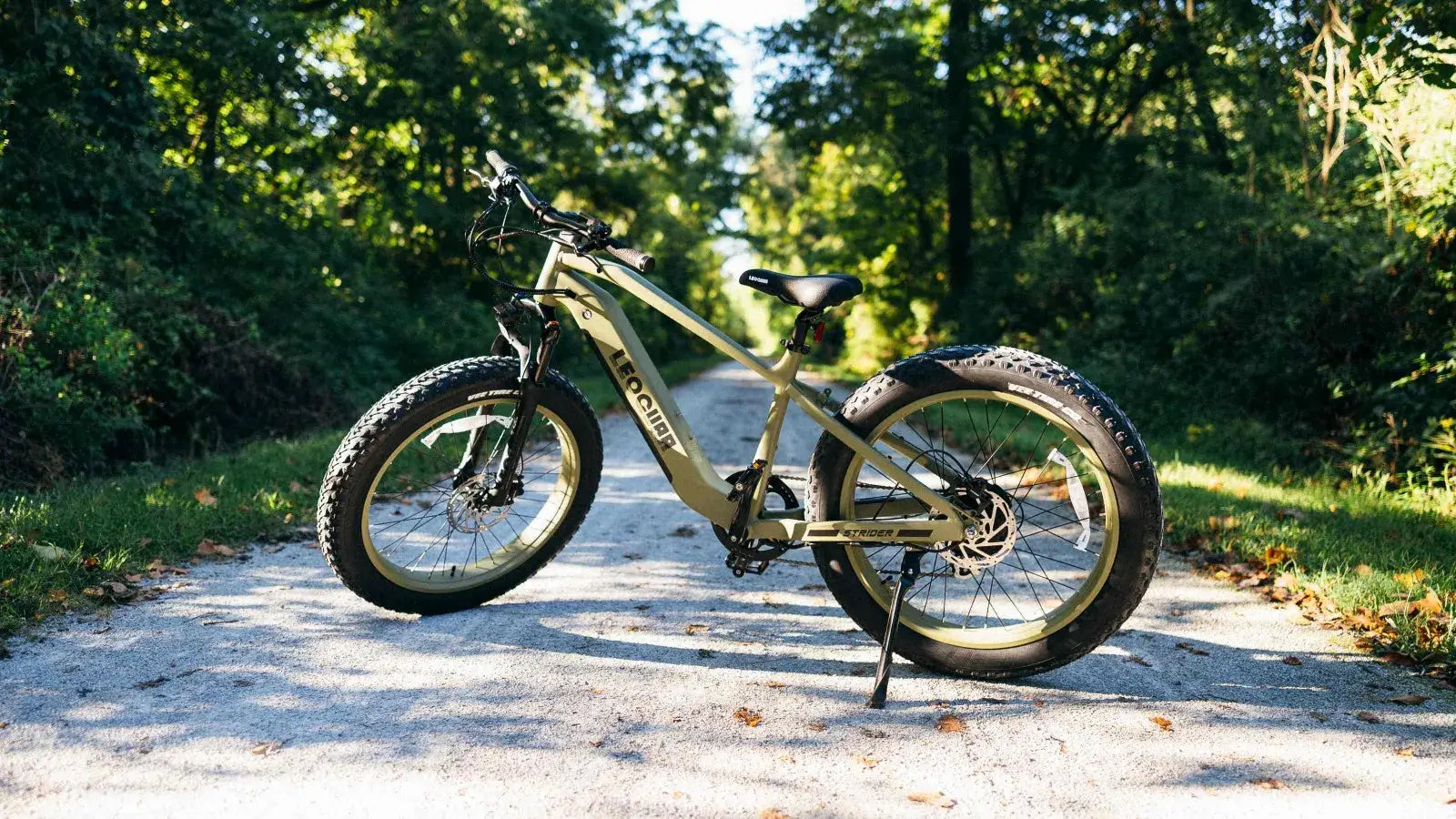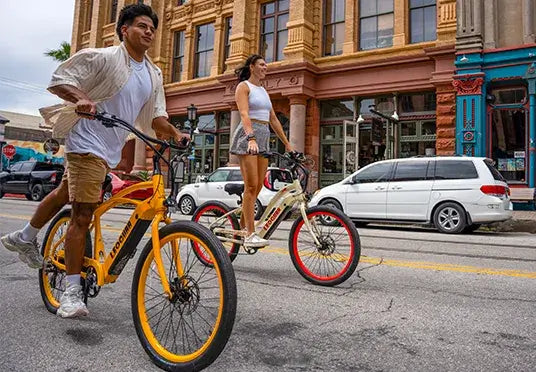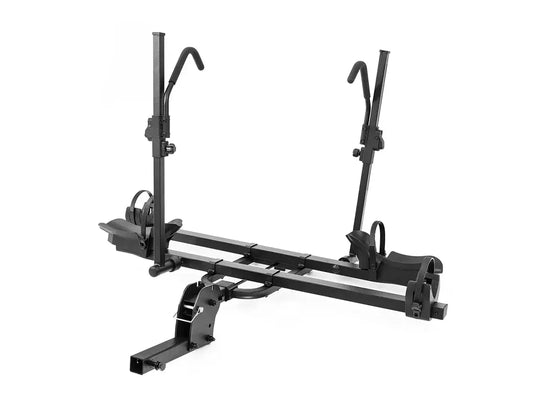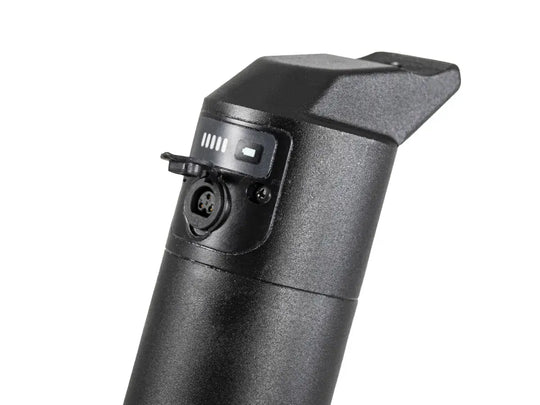
Common Mistakes Beginners Make While Riding Your Fat Tire Electric Bike
Fat tire electric bikes have wider tires designed to handle various terrains, from paved roads to sand, snow, and gravel. They have an electric motor powered by a rechargeable battery, which can assist in pedaling or propelling the bike independently. These bikes are known for their versatility and ease of handling challenging conditions.
However, riding an electric bike differs from a regular bicycle. The added weight and power, combined with the unique tire structure, present a new set of challenges that many beginners need to prepare for. To effectively transition to a fat-tire electric bike, you need new skills and adequate information, as common mistakes can lead to significant issues.
This article contains insights and tips on the most common mistakes beginners make and how to avoid them. Whether you're a novice or looking to improve your skills, this guide will help you ride confidently and safely.

What Should You Not Do on an Electric Bike?
Mistake 1: Neglecting Safety Gear
One of the most critical mistakes beginners make is overlooking the importance of safety gear. When riding a fat tire electric bike, especially at higher speeds or on rough terrain, you must wear a helmet to protect you from head injuries in case of a fall or collision. Additionally, wearing knee and elbow pads would protect you from severe injuries during accidents.
To ride safely:
- Always wear a properly fitted helmet.
- Consider additional protective gear such as knee and elbow pads.
- Wear reflective clothing if riding at night or in low-light conditions for visibility.
Mistake 2: Leaving the Battery Flat or Overcharged
Electric bike battery care is an important aspect of extending the life of your beginner ebike. Simple habits like charging regularly and avoiding extreme temperatures can significantly improve battery lifespan. Regularly letting the battery reach 0% or 100% can stress it and reduce its capacity over time, meaning you'll get fewer miles on a single charge.
Deep discharges can also cause the battery to enter a protective state where it won't hold a charge. Overcharging can damage the battery internally and lead to overheating, which is a safety hazard.
Also, ensure you use the charger that came with your Leoguar e-bike or one specifically designed for its battery. Third-party chargers might not regulate voltage properly. If you store your beginner ebike for a long time (weeks or months), first partially charge the battery to around 50%. Then, check on it periodically and top it up if it falls below 20%.
Mistake 3: Ignoring Electric Bike Error Codes
Here is the error code indicator for the Leoguar Fastron SO, providing clarity on ebike troubleshooting:
| Code | Meaning | Common Solution |
| 02 | Overcurrent | Check the Motor Cable Connection; Replace the Controller |
| 03 | Motor Blocked | Replace the Motor; Check the Controller |
| 04 | Low Voltage | Charge the Battery |
| 05 | Brake Fault | Check the Two Brakes; Check the Wiring Harness |
| 06 | Motor Hall Sensor Fault | Check the Motor Cable Connection; Replace the Controller |
| 07 | Throttle Falat | Replace the Throttle; Check the Wiring Harness |
| 09 | Over Voltage | Match the System With the Correct Battery |
| 15 | Controller Communication Fault |
Check the Controller Connections; Replace The Controller; Check the Wiring Harness |
| 16 | Battery Communication Fault | Replace the Display; Check the Battery; Replace The Controller |
Fat tire electric bikes have electronic systems that display electric bike error codes to indicate issues with the motor, battery, or other components. Ignoring these error codes or not understanding their meaning can lead to more significant electric bike problems and costly repairs down the line.
Refer to Leoguar's user manual to understand the meaning of each electric bike error code. If an error code appears, stop riding and seek assistance from a professional. Also, regularly check for software updates to ensure your bike's system is current.

Mistake 4: Misunderstanding the Use of Pedal Assist and Throttle
Fat tire electric bikes typically offer two modes of assistance: pedal assist and throttle. Pedal assist provides power when the rider pedals, while the throttle allows the rider to control the speed with a twist or button without pedaling. Many new e-bike riders need clarification on how the pedal assist and throttle work together. The pedal assist is the core function of an beginner ebike. It acts like a helper, providing extra power to your pedaling. The assist level typically increases as you pedal harder, up to a pre-set limit.
Using pedal assist in conjunction with pedaling is the most efficient way to ride an e-bike. It maximizes battery life and gives you a good workout. Relying solely on the throttle drains the battery much faster and offers less exercise. Pedal assist allows for a more natural riding experience, closer to a traditional bike. The throttle is helpful for situations where pedaling is difficult, but overuse can make riding less engaging.
Mistake 5: Not Using the Correct Gear
Electric bikes with multiple gears, like your Leoguar Fastron SO's 5-gear system, offer a wider range of riding possibilities. However, using the wrong gear can negatively impact your riding experience and efficiency and even damage your bike.
Gears allow you to adjust the ratio between your pedaling effort and the rotation of the wheels. Lower gears make pedaling easier but result in slower travel, while higher gears require more effort but enable faster speeds.
Being in the right gear allows the motor to assist you most effectively. Using a gear that's too high for the terrain will strain the motor and drain the battery faster. Conversely, a gear that's too low will make pedaling unnecessarily difficult. Also, you need to note that the motor's power delivery is optimized for specific gear ranges. Incorrect gear selection can lead to the motor feeling sluggish or jerky.
When starting from a standstill or ascending a hill, begin with a lower gear to make pedaling easier and give the motor the leverage it needs to assist effectively. As you gain speed, shift gradually to higher gears. This will comfortably maintain your pedaling cadence (revolutions per minute) while optimizing motor assistance.
If you feel excessive strain while pedaling, shift to a lower gear. Conversely, change to a higher gear if you're spinning too fast with minimal resistance. Before reaching an uphill section, shift to a lower gear in advance to avoid putting stress on the motor and drivetrain—similarly, downshift before tackling a downhill section to maintain control.
The more you ride your Leoguar Fastron SO, the more intuitive the gear selection will become. Experiment with different gear combinations on various terrains to understand how they affect your ride.

Mistake 6: Skipping Bike Maintenance
Proper maintenance is needed for the longevity and performance of any bike, including fat tire electric bikes. Beginners often overlook regular maintenance, which can lead to issues such as premature wear of components, reduced efficiency, and potential safety hazards. By staying on top of maintenance tasks, you'll prolong the life of your fat tire electric bike and enhance your riding experience. Here is a maintenance checklist to help:
- Check tire pressure: Maintain the recommended tire pressure to ensure optimal grip and efficiency.
- Inspect brakes: Regularly check brake pads for wear and adjust or replace them for effective braking.
- Clean and lubricate chain: Keep the chain clean to prevent rust and ensure smooth gear shifting.
- Inspect frame and components: Check for loose bolts, cracks, or any signs of damage that may compromise safety.
- Verify electrical connections: Ensure all electrical connections are secure and free from corrosion.
Mistake 7: Attempting Difficult Trails Too Soon
There are several reasons why beginners should wait to attempt difficult trails. Difficult trails often have obstacles like steep inclines, loose rocks, sharp turns, and narrow paths. It would be best to develop adequate experience and skills to handle these challenges safely. A fall on a difficult trail can lead to serious injuries, especially with a heavier e-bike.
Also, difficult trails demand more bike handling and maneuvering skills. Beginners might need help with balance, braking, and shifting gears on uneven terrain, increasing the risk of accidents. These trails can be physically demanding. You can get exhausted quickly, leading to fatigue and potentially poor decisions on the trail.
Struggling on a problematic trail can be frustrating and discouraging, especially for beginners. This could lead to a negative association with the activity and hinder your long-term enjoyment.
Conclusion
Riding an electric bike is worthwhile. However, you must be mindful of several common mistakes to ensure safety, optimize bike performance, and maximize enjoyment. Always wear a helmet and consider additional protective gear. Avoid leaving the battery flat or overcharged. You also need to understand and respond to electric bike error codes promptly. Use the pedal assist and throttle modes to conserve battery and optimize riding efficiency.
In addition, regularly inspect and maintain your beginner ebike to prevent issues and ensure longevity. Riding a fat-tire electric bike like the Leoguar Fastron ST gives you a unique blend of adventure and convenience. By avoiding these common mistakes and following basic guidelines, you'll confidently enhance your riding experience and explore new terrains.









































Leave a comment